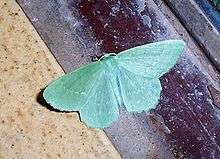Large emerald
The large emerald (Geometra papilionaria) is a moth which is the type species for the family Geometridae. It is found throughout the Palearctic region and the Near East. The species was first described by Carl Linnaeus in his 1758 10th edition of Systema Naturae.
| Large emerald | |
|---|---|
 | |
| Scientific classification | |
| Kingdom: | |
| Phylum: | |
| Class: | |
| Order: | |
| Family: | |
| Tribe: | Geometrini |
| Genus: | |
| Species: | G. papilionaria |
| Binomial name | |
| Geometra papilionaria | |
Description
This is a large and attractive moth, which, as the specific name suggests, is very butterfly like. It has a wingspan of 50–65 mm. Newly emerged adults are bright green with darker green and white fascia, though the green colouration fades after a few days. The characteristic fascia take the form of three jagged, broken lines of white spots on the forewings, of which two semicircular rows continue over the hindwings. It flies at night from June to August [1] and is attracted to light.
Biology
The larva is brown at first, turning green later, and feeds mainly on birch though it has also been recorded on alder, beech, hazel and rowan. The species overwinters as a larva.
 Caterpillar before (left) and after sprouting (right)
Caterpillar before (left) and after sprouting (right)04(js).jpg) Front view of the moth
Front view of the moth
Subspecies
- G. p. papilionaria Europe to the Urals, Southwest Siberia, Turkey, Caucasus, Transcaucasus
- G. p. herbacearia Ménétries, 1859 West Siberia - Southeast Siberia, Korea
- G. p. subrigua (Proute, 1935) Japan
References
- The flight season refers to the British Isles. This may vary in other parts of the range.
- Chinery, Michael Collins Guide to the Insects of Britain and Western Europe 1986 (Reprinted 1991)
- Skinner, Bernard Colour Identification Guide to Moths of the British Isles 1984
External links
| Wikimedia Commons has media related to Geometra papilionaria. |
| Wikispecies has information related to Geometra papilionaria |
- Large emerald at UKMoths
- Fauna Europaea
- Lepiforum e.V.
- Savela, Markku. "Geometra papilionaria (Linnaeus, 1758)". Lepidoptera and Some Other Life Forms. Retrieved April 18, 2019.